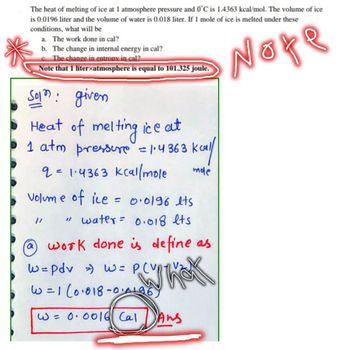
College Physics
11th Edition
ISBN: 9781305952300
Author: Raymond A. Serway, Chris Vuille
Publisher: Cengage Learning
expand_more
expand_more
format_list_bulleted
Question

Transcribed Image Text:The heat of melting of ice at 1 atmosphere pressure and 0°C is 1.4363 kcal/mol. The volume of ice
is 0.0196 liter and the volume of water is 0.018 liter. If 1 mole of ice is melted under these
conditions, what will be
a. The work done in cal?
b. The change in internal energy in cal?
c. The change in entropy in cal?
Note
Note that 1 literxatmosphere is equal to 101.325 joule.
Sol":
given
Heat of melting ice at
1 atm pressure = 1.4363 kca
kcal/
2 = 1.4363 kcal/mole
mole
volume of ice = 0·0196 lts
" water = 0.018 lts
@ work done is define as
w=pdv » w = P(V₁
hot
W = 1 (0·018-00196)
W = 0·0016 Cal
Pay Kat
Ans
Expert Solution
This question has been solved!
Explore an expertly crafted, step-by-step solution for a thorough understanding of key concepts.
This is a popular solution
Trending nowThis is a popular solution!
Step by stepSolved in 2 steps with 2 images

Knowledge Booster
Learn more about
Need a deep-dive on the concept behind this application? Look no further. Learn more about this topic, physics and related others by exploring similar questions and additional content below.Similar questions
- A 39% maximum efficient coal-fired power plant needs to produce 600 MW of power. A. To achieve maximum efficiency, if the waste water is dumped into a 13 degree Celsius lake, what temperature must the steam be heated to? B. Since coal contains 27 kJ of energy per gram, how many kg of coal must be burned in a day?arrow_forwardConstant amount of ideal gas is kept inside a cylinder by a piston. Then the gas expands isothermally. Compare the initial (i) and the final (f) physical quantities of the gas to each other. ◆ The temperature Tf is ... T₁. The internal energy Uf is ... U₁. The volume Vf is . V₁. ◆ The entropy Sf is ... S₁. The pressure pf is ... P₁. equal to less than greater than Send Feedbackarrow_forwardA certain heat engine does 12.0 kJ of work and 8.50 kJ heat transfer occurs to the environment in a cyclical process. a. What was the heat transfer (in kJ) into this engine? b. What was the engine's efficiency (in percent)?arrow_forward
- A heat engine takes in 14 kJ of energy and rejects 6 kJ to a low temperature sink. 1. How much work does the engine produce? 2. What is the efficiency of the heat engine?arrow_forward5. For a system, the thermodynamic as)vn energy U is defined as a function of S, V, and n which is U(S,V,n) = kn3V 3e3nR %3D where S is the entropy, V is the volume, n is the number of moles, K is the constant, and R is the gas constant. Determine a. Based on the theory in Thermodynamics, (), T = Determine, b. Based on the theory in Thermodynamics, Pressure P = . S,n 5/8 Determine c. Determine ne d. Determine dU in dS, dV and dnarrow_forward1. A cylinder containing an ideal gas is rapidly compressed as a piston is very quickly pushed down. There are 30 moles of gas. Initial values are: T₁ = 350 K, P₁ = 300 kPa. The final Temperature is Tr 400 K. a. What kind of process is this? b. How much heat is exchanged during this process? C. What is the change in thermal energy of the gas during this process? فarrow_forward
- I need solutions question Barrow_forwardThe enthalpy of 36 g of water vapor increases by 1830 J when its temperature increases from 150C to 175C. Assume that water vapor is an ideal gas. 1. What is the molar specific heat at constant pressure in SI units for water vapor? 2. By how much did the water vapor’s thermal energy increase? Express your answer with the appropriate units.arrow_forward
arrow_back_ios
arrow_forward_ios
Recommended textbooks for you
 College PhysicsPhysicsISBN:9781305952300Author:Raymond A. Serway, Chris VuillePublisher:Cengage Learning
College PhysicsPhysicsISBN:9781305952300Author:Raymond A. Serway, Chris VuillePublisher:Cengage Learning University Physics (14th Edition)PhysicsISBN:9780133969290Author:Hugh D. Young, Roger A. FreedmanPublisher:PEARSON
University Physics (14th Edition)PhysicsISBN:9780133969290Author:Hugh D. Young, Roger A. FreedmanPublisher:PEARSON Introduction To Quantum MechanicsPhysicsISBN:9781107189638Author:Griffiths, David J., Schroeter, Darrell F.Publisher:Cambridge University Press
Introduction To Quantum MechanicsPhysicsISBN:9781107189638Author:Griffiths, David J., Schroeter, Darrell F.Publisher:Cambridge University Press Physics for Scientists and EngineersPhysicsISBN:9781337553278Author:Raymond A. Serway, John W. JewettPublisher:Cengage Learning
Physics for Scientists and EngineersPhysicsISBN:9781337553278Author:Raymond A. Serway, John W. JewettPublisher:Cengage Learning Lecture- Tutorials for Introductory AstronomyPhysicsISBN:9780321820464Author:Edward E. Prather, Tim P. Slater, Jeff P. Adams, Gina BrissendenPublisher:Addison-Wesley
Lecture- Tutorials for Introductory AstronomyPhysicsISBN:9780321820464Author:Edward E. Prather, Tim P. Slater, Jeff P. Adams, Gina BrissendenPublisher:Addison-Wesley College Physics: A Strategic Approach (4th Editio...PhysicsISBN:9780134609034Author:Randall D. Knight (Professor Emeritus), Brian Jones, Stuart FieldPublisher:PEARSON
College Physics: A Strategic Approach (4th Editio...PhysicsISBN:9780134609034Author:Randall D. Knight (Professor Emeritus), Brian Jones, Stuart FieldPublisher:PEARSON

College Physics
Physics
ISBN:9781305952300
Author:Raymond A. Serway, Chris Vuille
Publisher:Cengage Learning

University Physics (14th Edition)
Physics
ISBN:9780133969290
Author:Hugh D. Young, Roger A. Freedman
Publisher:PEARSON

Introduction To Quantum Mechanics
Physics
ISBN:9781107189638
Author:Griffiths, David J., Schroeter, Darrell F.
Publisher:Cambridge University Press

Physics for Scientists and Engineers
Physics
ISBN:9781337553278
Author:Raymond A. Serway, John W. Jewett
Publisher:Cengage Learning

Lecture- Tutorials for Introductory Astronomy
Physics
ISBN:9780321820464
Author:Edward E. Prather, Tim P. Slater, Jeff P. Adams, Gina Brissenden
Publisher:Addison-Wesley

College Physics: A Strategic Approach (4th Editio...
Physics
ISBN:9780134609034
Author:Randall D. Knight (Professor Emeritus), Brian Jones, Stuart Field
Publisher:PEARSON